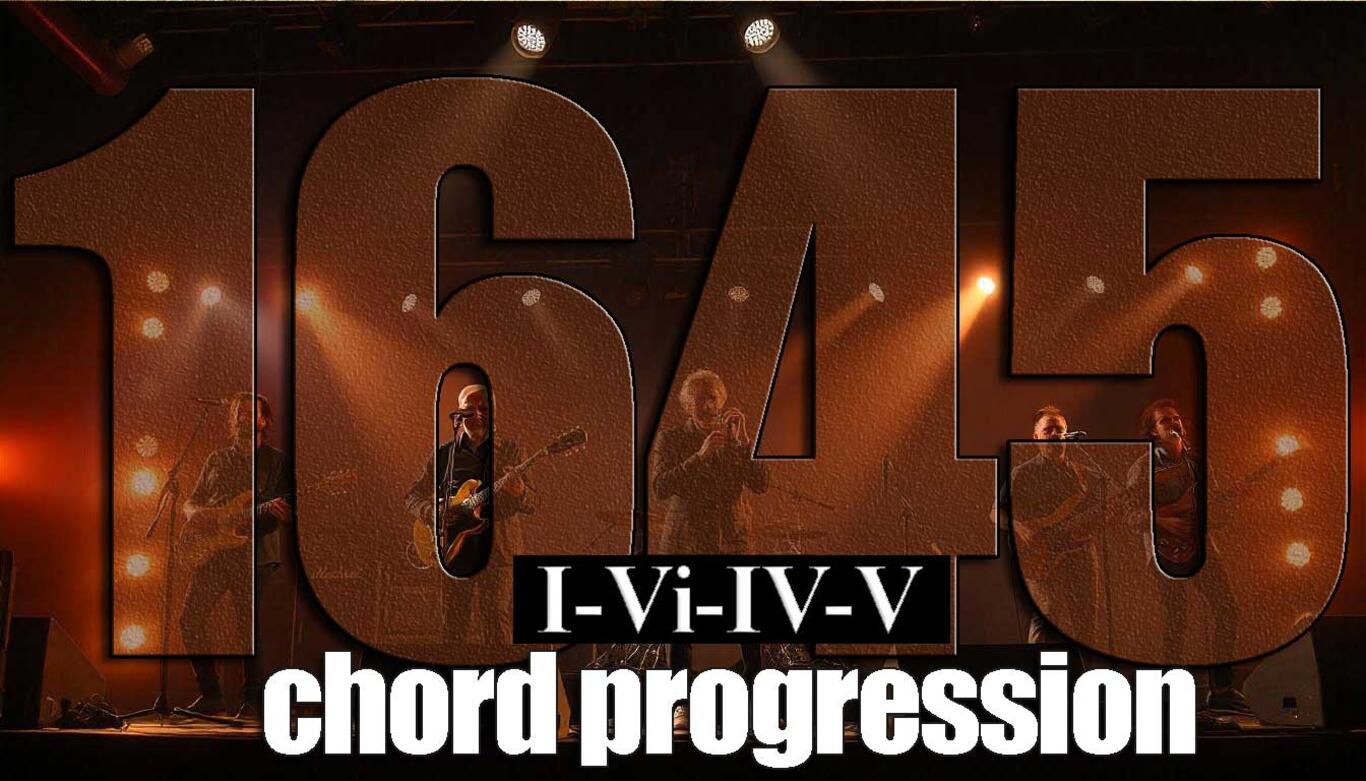The 1-6-4-5 Chord Progression: What It Is, Why It Works, and Famous Pop Tunes That Use It

Press Play to hear The 1-6-4-5 Chord Progression
This progression is also known as the Doo Wop or 50’s progression due to its popularity back in that era – it was the 1-5-4-6 of its day!
The 1-6-4-5 chord progression (I-vi-IV-V) is one of the most iconic and frequently used chord progressions in Western popular music. Its timeless appeal comes from its ability to evoke a wide range of emotions, from upbeat and joyful to wistful and melancholic. This progression has formed the backbone of many beloved songs in rock, pop, country, and other genres. It offers songwriters a simple but emotionally powerful tool for creating memorable music.
Famous Songs That Use the 1-6-4-5 Progression
Many hit songs have successfully used the 1-6-4-5 progression to create catchy and emotionally resonant music. Below are some examples of famous tunes across different genres that showcase the power of this chord progression.
1. “Let It Be” by The Beatles
- Key: C major (C - Am - F - G)
- One of the most iconic songs by The Beatles, "Let It Be" uses the 1-6-4-5 progression in a straightforward for the chorus and uses the closely related 1-5-4-6 chord-progression for the verses.
2. “No Woman, No Cry” by Bob Marley
- Key: C major (C - Am - F - G)
- This reggae classic is a perfect example of how the 1-6-4-5 progression can be used to create a mellow, reflective vibe. The gentle movement between the chords supports the song’s hopeful, reassuring lyrics.
3. “Unchained Melody” by The Righteous Brothers
- Key: G major (G - Em - C - D)
- "Unchained Melody" uses the 1-6-4-5 progression to evoke a sense of yearning and nostalgia. The transition from the major tonic to the minor vi chord creates an emotional depth that complements the song’s themes of love and longing.
4. “With or Without You” by U2
- Key: D major (D - Bm - G - A)
- U2’s "With or Without You" demonstrates the power of the 1-6-4-5 progression in building an anthemic, emotional ballad. The gradual build-up of the progression supports the song’s introspective lyrics and expansive sound.
5. “Stand by Me” by Ben E. King
- Key: A major (A - F#m - D - E)
- "Stand by Me" uses the 1-6-4-5 progression to create a soulful, uplifting message of support and loyalty. The interplay between the major and minor chords gives the song its emotional impact, making it a timeless anthem of solidarity.
6. “When I Come Around” by Green Day
- Key: G major (G - Em - C - D)
- This pop-punk hit from Green Day relies on the 1-6-4-5 progression to create an upbeat and energetic feel. The simplicity of the progression allows the song’s catchy melody and driving rhythm to shine.
7. “Every Breath You Take” by The Police
- Key: A major (A - F#m - D - E)
- "Every Breath You Take" makes use of the 1-6-4-5 progression to craft its hypnotic, repetitive sound. The balance between major and minor chords reinforces the song’s themes of obsession and longing.
8. “Can’t Help Falling in Love” by Elvis Presley
- Key: D major (D - Bm - G - A)
- This classic love song uses the 1-6-4-5 progression to evoke feelings of tenderness and vulnerability. The combination of the minor vi chord and the major tonic gives the song its gentle, romantic feel.
9. “Be My Baby” by The Ronettes
- Key: E major (E - C#m - A - B)
- A hallmark of the 1960s "Wall of Sound" era, "Be My Baby" uses the 1-6-4-5 progression to create an unforgettable pop classic. The progression provides a strong harmonic foundation for the lush arrangement and vocal harmonies.
10. “Time After Time” by Cyndi Lauper
- Key: F major (F - Dm - B♭ - C)
- "Time After Time" is a great example of how the 1-6-4-5 progression can be used to create a heartfelt ballad. The movement from the major tonic to the minor vi chord mirrors the emotional ups and downs of the lyrics, creating a powerful sense of longing.
- All I have to do is dream by the Everly Brothers
- I will always love you by Dolly Parton (made famous by Whitney Houston)
- Crocodile Rock by Elton John, Earth Angel by the Penguins
- Happiness is a Warm Gun by the Beatles
- Jesus of Suburbia by Green Day
- Baby by Justin Bieiber
What Is the 1-6-4-5 Progression?
The numbers 1, 6, 4, and 5 in this progression represent chords built on the corresponding scale degrees of a major key. These chords are referred to as the I (tonic), vi (submediant), IV (subdominant), and V (dominant) chords, respectively.
For example, in the key of C major, the progression would be:
- 1 (I) = C major
- 6 (vi) = A minor
- 4 (IV) = F major
- 5 (V) = G major
In the key of C major, the 1-6-4-5 progression would look like this:
- C - Am - F - G
Here’s how the progression looks in a few other common keys:
- Key of G major: G - Em - C - D
- Key of D major: D - Bm - G - A
- Key of A major: A - F#m - D - E
This progression’s magic lies in its blend of major and minor chords. The tonic (I) provides a sense of home or stability, the vi (minor) introduces emotional depth, the IV chord builds tension and complexity, and the V chord creates a sense of expectation that resolves back to the tonic.
Conclusion
The 1-6-4-5 chord progression has earned its place as one of the most beloved and frequently used progressions in Western music.






